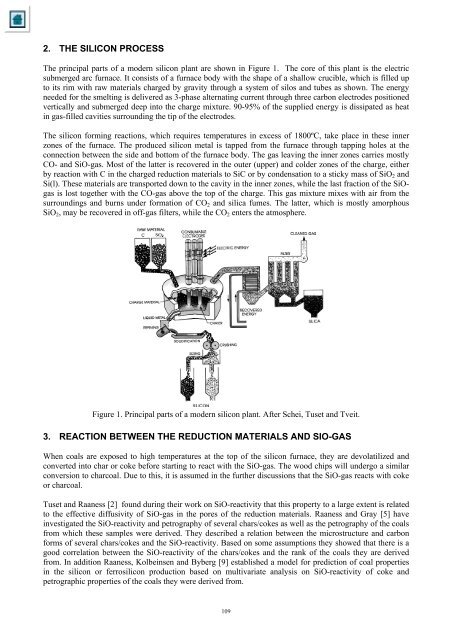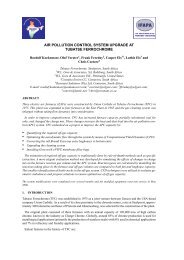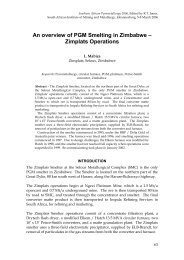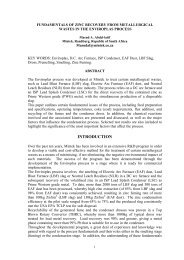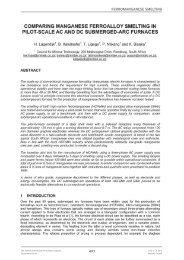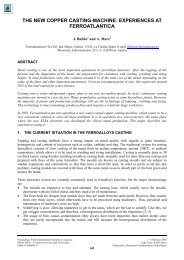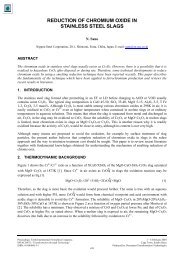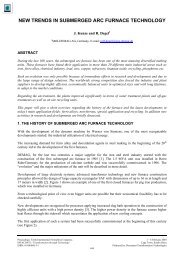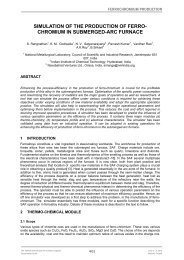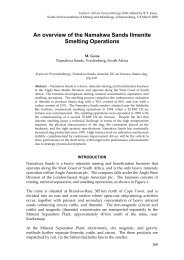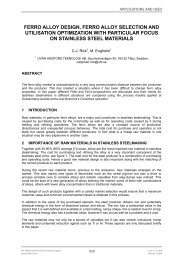Reaction Mechanisms of Charcoal and Coke in the ... - Pyro.co.za
Reaction Mechanisms of Charcoal and Coke in the ... - Pyro.co.za
Reaction Mechanisms of Charcoal and Coke in the ... - Pyro.co.za
Create successful ePaper yourself
Turn your PDF publications into a flip-book with our unique Google optimized e-Paper software.
2. THE SILICON PROCESSThe pr<strong>in</strong>cipal parts <strong>of</strong> a modern sili<strong>co</strong>n plant are shown <strong>in</strong> Figure 1. The <strong>co</strong>re <strong>of</strong> this plant is <strong>the</strong> electricsubmerged arc furnace. It <strong>co</strong>nsists <strong>of</strong> a furnace body with <strong>the</strong> shape <strong>of</strong> a shallow crucible, which is filled upto its rim with raw materials charged by gravity through a system <strong>of</strong> silos <strong>and</strong> tubes as shown. The energyneeded for <strong>the</strong> smelt<strong>in</strong>g is delivered as 3-phase alternat<strong>in</strong>g current through three carbon electrodes positionedvertically <strong>and</strong> submerged deep <strong>in</strong>to <strong>the</strong> charge mixture. 90-95% <strong>of</strong> <strong>the</strong> supplied energy is dissipated as heat<strong>in</strong> gas-filled cavities surround<strong>in</strong>g <strong>the</strong> tip <strong>of</strong> <strong>the</strong> electrodes.The sili<strong>co</strong>n form<strong>in</strong>g reactions, which requires temperatures <strong>in</strong> excess <strong>of</strong> 1800ºC, take place <strong>in</strong> <strong>the</strong>se <strong>in</strong>nerzones <strong>of</strong> <strong>the</strong> furnace. The produced sili<strong>co</strong>n metal is tapped from <strong>the</strong> furnace through tapp<strong>in</strong>g holes at <strong>the</strong><strong>co</strong>nnection between <strong>the</strong> side <strong>and</strong> bottom <strong>of</strong> <strong>the</strong> furnace body. The gas leav<strong>in</strong>g <strong>the</strong> <strong>in</strong>ner zones carries mostlyCO- <strong>and</strong> SiO-gas. Most <strong>of</strong> <strong>the</strong> latter is re<strong>co</strong>vered <strong>in</strong> <strong>the</strong> outer (upper) <strong>and</strong> <strong>co</strong>lder zones <strong>of</strong> <strong>the</strong> charge, ei<strong>the</strong>rby reaction with C <strong>in</strong> <strong>the</strong> charged reduction materials to SiC or by <strong>co</strong>ndensation to a sticky mass <strong>of</strong> SiO 2 <strong>and</strong>Si(l). These materials are transported down to <strong>the</strong> cavity <strong>in</strong> <strong>the</strong> <strong>in</strong>ner zones, while <strong>the</strong> last fraction <strong>of</strong> <strong>the</strong> SiOgasis lost toge<strong>the</strong>r with <strong>the</strong> CO-gas above <strong>the</strong> top <strong>of</strong> <strong>the</strong> charge. This gas mixture mixes with air from <strong>the</strong>surround<strong>in</strong>gs <strong>and</strong> burns under formation <strong>of</strong> CO 2 <strong>and</strong> silica fumes. The latter, which is mostly amorphousSiO 2 , may be re<strong>co</strong>vered <strong>in</strong> <strong>of</strong>f-gas filters, while <strong>the</strong> CO 2 enters <strong>the</strong> atmosphere.Figure 1. Pr<strong>in</strong>cipal parts <strong>of</strong> a modern sili<strong>co</strong>n plant. After Schei, Tuset <strong>and</strong> Tveit.3. REACTION BETWEEN THE REDUCTION MATERIALS AND SIO-GASWhen <strong>co</strong>als are exposed to high temperatures at <strong>the</strong> top <strong>of</strong> <strong>the</strong> sili<strong>co</strong>n furnace, <strong>the</strong>y are devolatilized <strong>and</strong><strong>co</strong>nverted <strong>in</strong>to char or <strong>co</strong>ke before start<strong>in</strong>g to react with <strong>the</strong> SiO-gas. The wood chips will undergo a similar<strong>co</strong>nversion to char<strong>co</strong>al. Due to this, it is assumed <strong>in</strong> <strong>the</strong> fur<strong>the</strong>r discussions that <strong>the</strong> SiO-gas reacts with <strong>co</strong>keor char<strong>co</strong>al.Tuset <strong>and</strong> Raaness [2] found dur<strong>in</strong>g <strong>the</strong>ir work on SiO-reactivity that this property to a large extent is relatedto <strong>the</strong> effective diffusivity <strong>of</strong> SiO-gas <strong>in</strong> <strong>the</strong> pores <strong>of</strong> <strong>the</strong> reduction materials. Raaness <strong>and</strong> Gray [5] have<strong>in</strong>vestigated <strong>the</strong> SiO-reactivity <strong>and</strong> petrography <strong>of</strong> several chars/<strong>co</strong>kes as well as <strong>the</strong> petrography <strong>of</strong> <strong>the</strong> <strong>co</strong>alsfrom which <strong>the</strong>se samples were derived. They described a relation between <strong>the</strong> microstructure <strong>and</strong> carbonforms <strong>of</strong> several chars/<strong>co</strong>kes <strong>and</strong> <strong>the</strong> SiO-reactivity. Based on some assumptions <strong>the</strong>y showed that <strong>the</strong>re is agood <strong>co</strong>rrelation between <strong>the</strong> SiO-reactivity <strong>of</strong> <strong>the</strong> chars/<strong>co</strong>kes <strong>and</strong> <strong>the</strong> rank <strong>of</strong> <strong>the</strong> <strong>co</strong>als <strong>the</strong>y are derivedfrom. In addition Raaness, Kolbe<strong>in</strong>sen <strong>and</strong> Byberg [9] established a model for prediction <strong>of</strong> <strong>co</strong>al properties<strong>in</strong> <strong>the</strong> sili<strong>co</strong>n or ferrosili<strong>co</strong>n production based on multivariate analysis on SiO-reactivity <strong>of</strong> <strong>co</strong>ke <strong>and</strong>petrographic properties <strong>of</strong> <strong>the</strong> <strong>co</strong>als <strong>the</strong>y were derived from.


